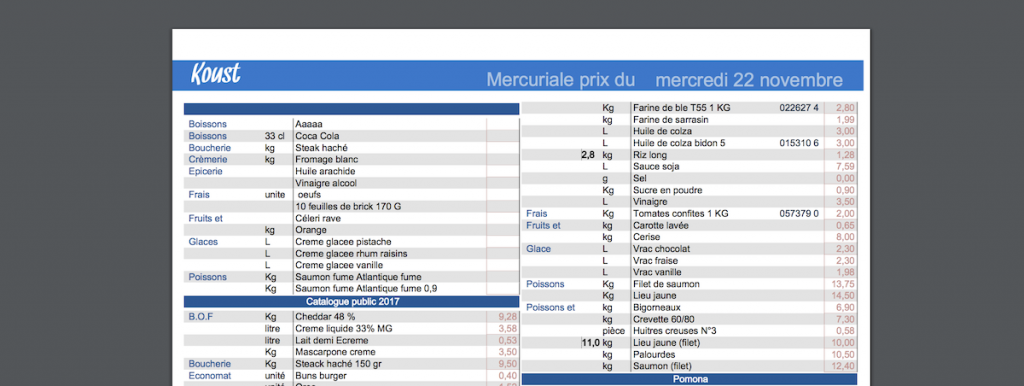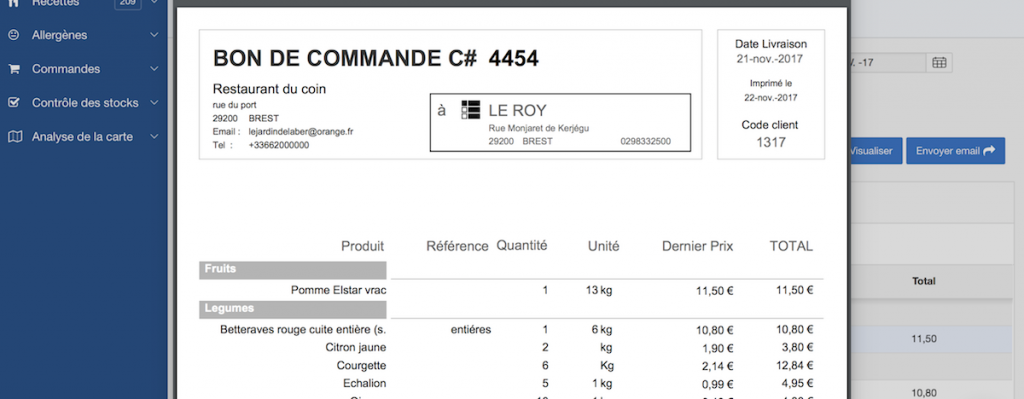
Facilitating supplier orders
How to facilitate supplier orders? A lot of fresh products, fluctuating prices, perishable foodstuffs, stocks that are difficult to evaluate, to simplify the preparation of orders specific tools for the catering industry are essential.
What constraints, what to simplify?
1- Putting suppliers in competition
Faced with the diversity of suppliers' offers, and faced with variations in quality or price, the first constraint is to choose the right supplier and to be able to change in case of :
- Deterioration of product quality
- Price changes,
- Low quality of service,
- Supply shortage of merchandise,
- Delivery times are too long.
En général, les jours de commandes et de livraison sont réparties sur la semaine. Les fournisseurs appellent les uns après les autres. Certains proposent des services en ligne avec leurs contraintes propres. Une approche plus simple est de regrouper toutes les commandes à partir de la même plateforme. Pour gagner du temps à moyen terme, l’envoi des bons de commande par e-mail remplace une grande partie des appels téléphoniques.
Even if some of the purchases require live contact or negotiation, a large portion can be executed automatically. Perishable goods and stock optimisation require a visual inspection of the cold stores and storage shelves.
2- Calculate quantities to order easily
La transformation de matières premières en recettes, en plats, en articles sur la carte implique des commandes fournisseurs plus complexes. On doit donc transformer le menu du jour et le nombre de parts prévues en une liste de course. Pour établir cette liste, il faut souvent reprendre la fiche technique, si on veut optimiser les quantités. Surtout, si vous utilisez des produits frais et si vous voulez éviter le gaspillage, un pré-calcul est indispensable.
These cases mainly concern :
- the daily specials,
- group meals that have established a menu in advance
- establishments with precise information on the number of guests
3- Fewer unit calculations, fewer conversions
Les différents conditionnements se transforment en vraie difficulté pour les professionnels de la restauration, non seulement pour comparer les différents conditionnements, mais aussi pour chiffrer les fiches techniques. Donc quand on remplace un conditionnement de 900 g par un autre de 750 g, il est indispensable de décrire la recette en gramme.
Quand on achète des cartons de 5 kg d’une denrée, la ligne de facture peut multiplier un prix unitaire ou être directement évalué pour 5 kg. Devant cette diversité de méthode de facturation, le suivi des prix devient vite déplaisant.
4- Transforming orders into invoices
Of course, the generation of supplier orders implies being able to convert them into invoices. Indeed, the next step is to be able to follow theevolution of prices, the quantities of ingredients purchased over a period of time and the amount spent with each supplier. Not only will this facilitate negotiations, but it is also essential for management control.
The only constraint is that you can change the delivery quantities. For example, if you order 5 kg of rib steak, your vendor will deliver a quantity close to, but not exactly 5 kg. The price may also change, and this change must be taken into account for the next order. Indeed, if a supplier increases his prices, he takes the risk of no longer being listed if he becomes more expensive than another.
Supplier ordering solutions in Koust
To meet these constraints specific to restoration, the koust software provides simple tools dedicated to each step. The constituted data give a formidable advantage to the manager for the follow-up of quality and costs.
Comparison and choice of suppliers
Several suppliers can be referenced per ingredient. By default, the best price is chosen, but the software gives the possibility to force a supplier. When prices evolve, the choice of supplier can also change.
Mercuriales
The mercurials are used to carry out the commands. There are several ways to represent them:
- minimum price sorting: cheapest supplier
- tri total : pour chaque ingrédient, lister toutes les propositions des grossistes
- by supplier: list of ingredients sorted by supplier
These mercuriales can evolve over time according to your wholesalers' proposals or orders and invoices.
Preparation of supplier orders
Afin de préremplir vos bons de commande ou vos mercuriales, la fonction “préparation de commandes fournisseurs” permet de saisir :
- the number of recipes to be transformed into quantities to be ordered
- the quantity of each ingredient
- or both
Generating and Sending Orders
After filling in the quantities described in the previous chapter, purchase orders can be generated with these merchandise requirements. The choice of supplier is established in the same way as in the mercuriales (minimum price). However, this choice can be modified.
Le bon de commande est chiffré par les derniers prix enregistrés afin d’estimer le coût total des achats. Enfin, les références fournisseurs lèveront toutes confusions possibles.
Convert the order into an invoice
La transformation des commandes fournisseurs en facture vous économise la saisie des détails de celle-ci. Il reste quelques changements de poids, changement de référence ou des prix à rectifier si besoin. Ensuite, le logiciel vous propose de modifier le prix de référence si les prix évoluent.
Quand il y a des modifications ou quand vous n’avez pas de bon de commande, koust simplifie la saisie. Un outil de recherche aide aussi à retrouver une référence ou de la créer rapidement si besoin. Les quantités du conditionnement peuvent varier. Vous pouvez ainsi saisir le prix unitaire ou le prix total sur vos ingrédients achetés.




